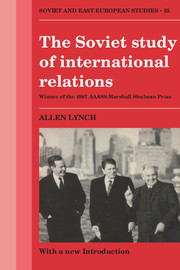Book contents
- Frontmatter
- Contents
- Foreword by Curt Gasteyger
- Acknowledgements
- INTRODUCTION: THE “ NEW POLITICAL THINKING” AND SOVIET FOREIGN POLICY: INTELLECTUAL ORIGINS AND POLITICAL CONSEQUENCES
- INTRODUCTION TO THE FIRST EDITION
- 1 THE BACKGROUND: MARX, LENIN, STALIN AND THE THEORY OF INTERNATIONAL RELATIONS
- 2 THE DEVELOPMENT OF SOVIET POLITICAL STUDIES
- 3 APPROACHES TO INTERNATIONAL RELATIONS
- 4 THE SYSTEMS APPROACH AND INTERNATIONAL RELATIONS
- 5 THE STRUCTURE OF THE INTERNATIONAL SYSTEM: THE SYSTEMS LEVEL
- 6 CRITICAL SUBSYSTEMS
- 7 THE SCIENTIFIC–TECHNICAL REVOLUTION AND THE CHANGING FACE OF INTERNATIONAL RELATIONS
- CONCLUSION
- Notes
- Bibliography
- Index
- SOVIET AND EAST EUROPEAN STUDIES
3 - APPROACHES TO INTERNATIONAL RELATIONS
Published online by Cambridge University Press: 05 August 2011
- Frontmatter
- Contents
- Foreword by Curt Gasteyger
- Acknowledgements
- INTRODUCTION: THE “ NEW POLITICAL THINKING” AND SOVIET FOREIGN POLICY: INTELLECTUAL ORIGINS AND POLITICAL CONSEQUENCES
- INTRODUCTION TO THE FIRST EDITION
- 1 THE BACKGROUND: MARX, LENIN, STALIN AND THE THEORY OF INTERNATIONAL RELATIONS
- 2 THE DEVELOPMENT OF SOVIET POLITICAL STUDIES
- 3 APPROACHES TO INTERNATIONAL RELATIONS
- 4 THE SYSTEMS APPROACH AND INTERNATIONAL RELATIONS
- 5 THE STRUCTURE OF THE INTERNATIONAL SYSTEM: THE SYSTEMS LEVEL
- 6 CRITICAL SUBSYSTEMS
- 7 THE SCIENTIFIC–TECHNICAL REVOLUTION AND THE CHANGING FACE OF INTERNATIONAL RELATIONS
- CONCLUSION
- Notes
- Bibliography
- Index
- SOVIET AND EAST EUROPEAN STUDIES
Summary
INTRODUCTION
Most observers, both Soviet and Western, see the year 1956, the year of the twentieth Soviet Party Congress and Khrushchev's “secret speech” denouncing Stalin's “crimes” against the Party, as the critical turning point in Soviet thinking on international relations. Two ideological revisions – the breaking of the capitalist encirclement by the Soviet Union, and the non-inevitability of general war, were of special significance. They openly suggested that, as had been implicit in Stalin's critique of socialism-in-one-country, henceforth the revolutionary transformation of the world would be effected through international relations. States had now become protagonists in the class conflict. The increased importance that relations among nation-states were held to have for the future of socialism required going beyond the “rather mechanistic transplant of theses regarding internal relations and laws of society to external, intersocietal relations.” From this date ensues the proliferation of Soviet research institutes devoted to the systematic study of international relations, a consequence of the transformation of international relations into a legitimate area of inquiry below the apex of the Party–government apparatus. From 1962 on international relations as such begins to emerge as a self-conscious discipline. Vladimir Gantman, for example, now head of the Theory of International Relations section of the Institute of the World Economy and International Relations, objected to one writer's denial of the possibility of setting up a science of international relations and asserted in reply that such a science does exist as an autonomous discipline of study.
- Type
- Chapter
- Information
- The Soviet Study of International Relations , pp. 32 - 70Publisher: Cambridge University PressPrint publication year: 1987



